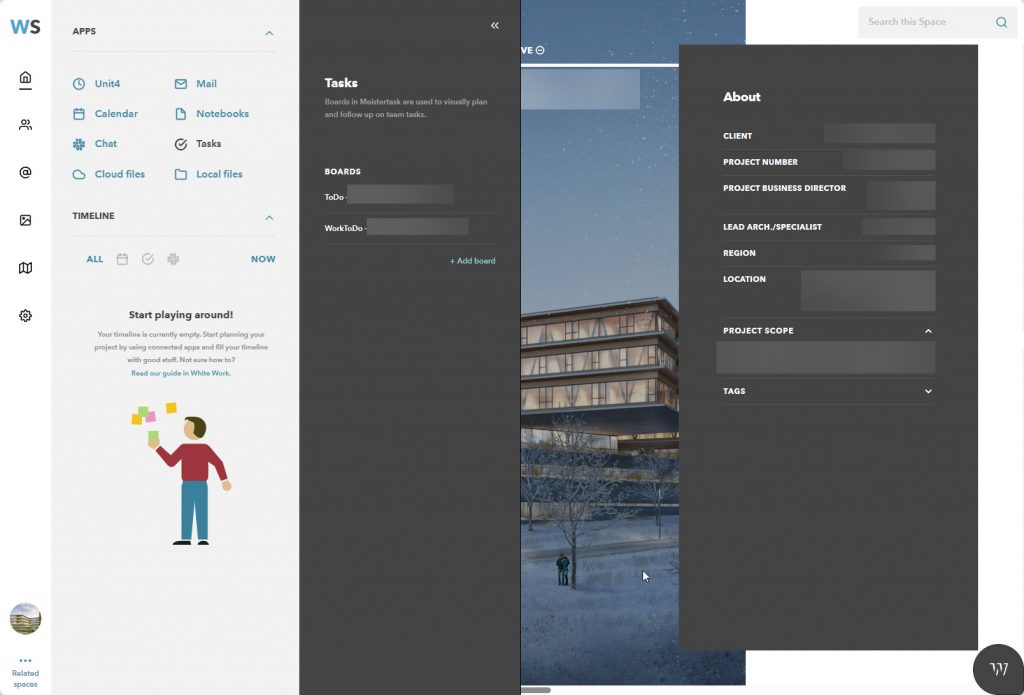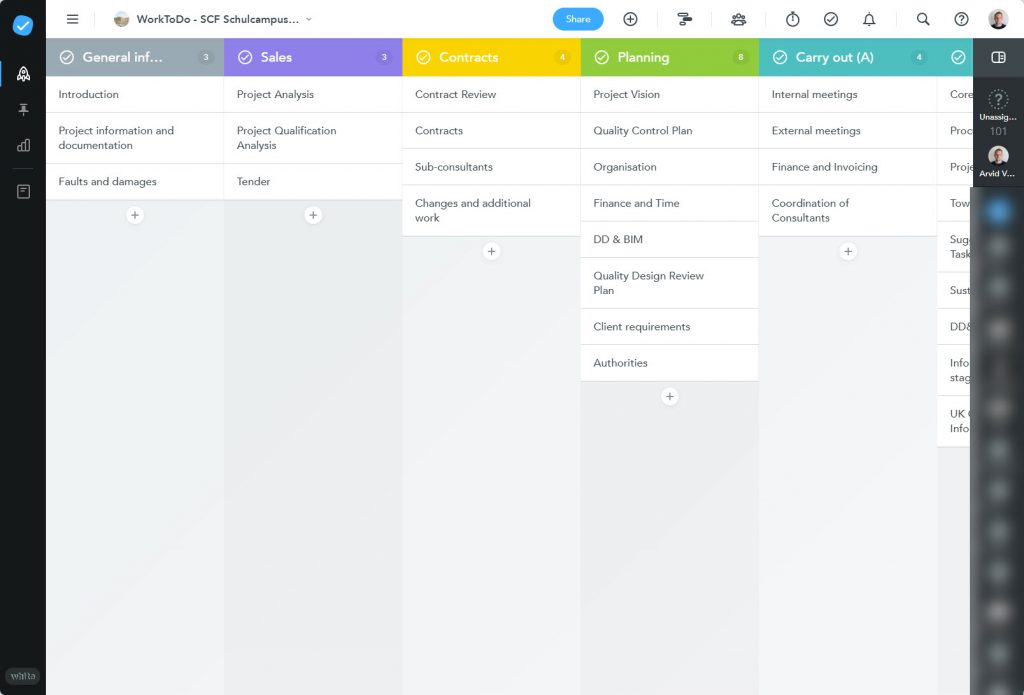How White Uses MeisterTask to Streamline Workflows for Complex Projects.

Industry
Construction
Employees
100+
Region
Europe
Use Case
Workflow Management
In this Story

White Arkitekter: Enabling Sustainable Life Through the Art of Architecture.
From schools and hospitals to housing projects and urban landscapes, White Arkitekter has been designing innovative and sustainable spaces since 1951. With over 700 employees and operations in Sweden, Norway, the United Kingdom, Germany, Canada and East Africa, they are one of the leading architectural practices in Scandinavia. The company is on a mission to “enable sustainable life through the art of architecture” and ensure their architecture is 100% climate neutral by 2030.
White’s award-winning builds are created to inspire and engage, where people can thrive and grow in harmony with the environment. But bringing these highly ambitious architectural projects to life is a huge undertaking that requires rigorous planning and oversight. A robust digital workspace is central to the team’s daily operations. MeisterTask and MindMeister have been a core piece of White’s tech stack since 2017, helping their team bring structure and simplicity to their multi-year projects. But it wasn’t always such smooth sailing.
The Challenge: No Clear Overview, Too Much Room for Error.
Arvid Vessman, White’s Service Owner responsible for digital spaces, joined White after MeisterTask and MindMeister had been implemented – though he was more than happy to inherit the tools. Arvid explains that MeisterTask and MindMeister were selected as part of a push towards a “best of breed” strategy initiated by White’s CIO, Peter Leuchovius. With so many project requirements to meet, their digital toolset had to be second to none. Previously, the team had been using Lotus Notes – described by Arvid as “a tool from another time” – to plan and manage their projects. Lotus Notes simply couldn’t keep up with the team’s complex workflows. Arvid explains:

“Our projects vary in size depending on the context of what needs to be done. Each of these projects have different requirements, documentation, and gateways. As an architecture firm, there are a lot of strict requirements that we have to follow for a project to be successful. It’s important that nothing is missed or forgotten.”
Arvid Vessman
Service Owner responsible for digital spaces, White Arkitekter
To meet the demands of their projects, the team at White needed a way to keep track of every step in the process – and fast. They wanted a project management tool that could be implemented quickly, so simplicity and ease of use were high on the agenda. This is where MeisterTask excels.
The Solution: Standardized and Automated Workflows with MeisterTask.
As White’s projects are broad in scope and high in complexity, it’s important that project managers have everything they need to manage their projects from the outset. For ease and efficiency, and to remove as much manual set-up as possible, Arvid and his team are responsible for creating and maintaining “White Spaces” – an in-house platform where users can interact with a subset of project tools. Here, Meister tools are used in combination with Slack for instant messaging, OneNote for documentation, and Egnyte for large file storage. Collectively, this toolkit ensures project managers can deliver on requirements while remaining confident that nothing is overlooked.

Each space has a templatized MeisterTask project board which provides a baseline of what is required within each project, along with guidance on processes.
“The board contains tasks with all the gateways and steps in the process, so the project manager knows what needs to be done and in what order. It spans the entire process, from contracts and planning right through to client surveys, customer feedback and lessons learned. Because each project has so many connected tasks, being able to automate parts of the process in MeisterTask is a big advantage. ”

The team is currently working on a large project in Stuttgart. The project has an extensive timeline and multiple stages of development, all of which are visible in the MeisterTask project board. Arvid explains:
“This view gives the team visibility on what needs to be done. That doesn’t mean that everyone on the team is interacting with the board – the value lies in keeping everyone on the same page. Everyone working on this project checks it frequently to stay aligned and informed. As everything is archived, you can go back and follow up on who did what and when. It’s easy to backtrace and follow up as needed. ”
Project managers can add their own tasks and track their own workflows in separate “To Do” boards. As steps within each project are executed within these boards, they’re naturally more collaborative. Project managers typically use the traditional Kanban view to keep an overview of task progress, moving tasks through the sections and reassigning them to those responsible when it’s their turn to contribute. Tags are added to identify priorities, ie. prio 1, 2 or 3, which gives collaborators a quick and easy overview of what to focus on first. This ensures accountability and helps the team to consistently meet deadlines.
At the company level, MeisterTask is the go-to tool for annual action planning and budgeting. Project managers create a board for each project, outlining required resources including budget, stakeholders and expected timeline. These boards are then combined into a large overview project board where leadership can assess and prioritize all projects. As such, the planning process is centralized, transparent and clearly communicated to all team members.
Of course, behind every great plan is a great idea. Before plans are set in stone, some team members like to use their own personal MindMeister accounts to brainstorm and develop project concepts. The tool provides a creative space to explore possibilities and consider potential project outcomes.
“We have some MindMeister “super users” who really like the way MindMeister is structured – it helps them to get their thoughts in order and organized before they’re workshopped collectively in Mural.”
For those working in support functions, MeisterTask helps stay on top of a fast-moving stream of requests. Arvid explains:
“I have a roadmap board in MeisterTask for every digital platform I manage. Whenever there’s a bug, new feature or a general to-do, I create a task on the board. This helps me to plan my work and support each platform effectively.”
The MeisterTask-Slack automation used in combination with the Agenda helps Arvid to streamline the process of gathering, prioritizing and scheduling support tickets.
MeisterTask integrations are also a huge help for White’s Service Desk team, who use MeisterTask to keep track of Customer Support tickets.
“The team uses integrations between MeisterTask, Zendesk and Slack: it’s kind of a three-headed monster. They use Zendesk for tracking complex service tickets, from which they generate a MeisterTask task, which is then assigned to an agent. When a ticket is closed, a notification is automatically sent to their Slack channel. The team can refer back to how the issue was solved in MeisterTask, so they know how to handle the issue should it arise again in future. ”
The Outcome: Consistent Processes, Productive Teams, and Precise Project Execution.
Since introducing MeisterTask and MindMeister, White has been able to streamline their workflows to ensure greater efficiency and accountability. Requirements and responsibilities are clear for every project, whether large-scale architecture projects or internal support projects. Not only is project execution more thorough, with less room for to-dos to slip through the net, but they’ve also managed to save a lot of time through templatized processes and automations. Arvid says:
“There’s no question about it – we are saving a lot of time. To get all of that off-the-shelf support for a project and have a ready-to-use structure is extremely valuable. The learnings we’ve gathered from being able to track tasks and refer back to previous projects also saves us time in the long run.”
The flexibility of MeisterTask means it has been adapted for multiple use cases within the company. Arvid notes:
“One man’s chaos is another man’s order, so it really helps to be able to structure things in the way that you get the best overview, and in the way you feel comfortable keeping track of your work. I didn’t use a task management system before I started at White. It took some time to create the infrastructure we needed, but now it’s hard to see how I would be able to perform my work the way I do without MeisterTask.”

Your Best Projects Are Yet To Come.
Talk to a MeisterTask Expert!
Industry leaders everywhere are driving success with MeisterTask. Now it’s your turn.
or
